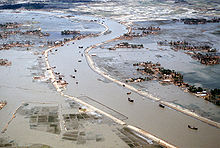1991 Bangladesh cyclone
| Category 5 cyclone ( SSHWS ) | ||
|---|---|---|
| VIS satellite image from April 29, 1991, 06:23 UTC. The cyclone was likely a Category 4 cyclone at the time and was still intensifying. | ||
| Emergence | April 22, 1991 | |
| resolution | April 30, 1991 | |
|
Peak wind speed |
|
|
| Lowest air pressure | 898 hPa ( mbar ) | |
| dead | > 138,000 dead, 10 million homeless |
|
| Property damage | $ 1.5 billion (1991) | |
|
Affected areas |
Bangladesh | |
The 1991 Bangladesh cyclone ( IMD designation: BOB 01, JTWC designation: 02B) was one of the most sacrificed tropical cyclones in history. On April 29, 1991, this violent cyclone with wind speeds of up to 260 km / h hit the Chittagong division in southeastern Bangladesh . The cyclone caused a six-meter high tidal wave that affected a large area. 138,000 people died and ten million became homeless.
Storm course
An area of heavy cloud cover, partly belonging to a monsoonal trough , developed into a tropical depression on April 22nd in the Bay of Bengal . The wind speed and the size of the lows increased. On April 24th, it was promoted to Tropical Storm 02B. The enormous wind field encompassed almost the entire Gulf.
The storm moved slowly northwest, gradually increasing in strength and reaching cyclone strength on April 27th. Initially, the cyclone moved between two high pressure areas in the northwest and in the east. When it was caught by the westerly wind at medium altitudes, it slowly turned north-east. The westerly wind flow supported the outflow of air masses in higher layers. In combination with the high water temperatures, the storm intensified further.
On April 28 and 29, when the cyclone accelerated north-east, it reached a strength comparable to a category five hurricane . On the evening of April 29, he went ashore just south of Chittagong , still with a Category 4 strength. This behavior shortly before reaching the country is reminiscent of Hurricane Katrina in 2005.
The storm weakened rapidly overland and dispersed over western Yunnan on April 30 .
Damage
Victim
At least 138,000 people were killed, most in Chittagong Division . Most drowned. The greatest number of victims were among children and the elderly. Although protective buildings were built after the devastating cyclone of 1970 , many people were only warned a few hours before the disaster and did not know where the protective buildings were. Others did not leave the endangered area believing the storm would not be as bad as predicted. On the other hand, it is estimated that two million people have been evacuated from the most vulnerable areas. Otherwise the number of victims would have been much higher.
Property damage
The storm caused about 1.5 billion US dollars (1991) damage. The hurricane and storm surge devastated the coast. For example, although a concrete dam protected the mouth of the Karnaphuli in Patenga south of Chittagong, it was washed away by the flood. The cyclone threw a 100-ton crane from the port of Chittagong onto a bridge over the Karnaphuli, which broke in two. Many boats and smaller ships were washed ashore.
The Bangladesh Air Force and Navy bases in Chittagong were also badly hit. The naval base " Isha Khan " in Patenga was flooded and many ships were badly damaged. Most of the fighter planes stationed there were also damaged.
Nearly a million homes were destroyed, leaving ten million people (nearly ten percent of the total population of Bangladesh) homeless.
Many bank fortifications, as well as entire villages, were simply washed away. Three to four weeks after the cyclone hit, erosion destroyed a lot of farmland and many farmers became unemployed.
International aid
A reaction force of the US Navy , consisting of 15 ships and 2500 men crew, which was on the way back from the Gulf War to the USA, was diverted to the Bay of Bengal. This was part of Operation Sea Angel, one of the largest military relief operations ever carried out, in which Great Britain, China, India, Pakistan and Japan also participated. Operation Sea Angel began on May 10, 1991 when US President Bush ordered the military to offer humanitarian aid. Over 7,000 soldiers were dispatched to Bangladesh and provided nearly two million people with food, water and medical aid. 3,000 tons of relief supplies saved the lives of 200,000 people.
Name of the hurricane
In several sources, the hurricane is referred to by different names, including "Gorky" and "Marian". However, it did not get an official name from the Joint Typhoon Warning Center . There it was referred to as "Tropical Cyclone 02B".
Individual evidence
- ^ G. Khalil: Cyclones and Storm Surges in Bangladesh: Some Mitigative Measures. In: Natural Hazards. Vol. 6, 1992, pp 11-24
- ^ G. Khalil: The Catastrophic Cyclone of April 1991: It's Impact on the Economy of Bangladesh. In: Natural Hazards. Vol. 8, 1993, pp 261-281
- ↑ inTERRAgate ( Memento of the original from June 10, 2008 in the Internet Archive ) Info: The archive link was inserted automatically and has not yet been checked. Please check the original and archive link according to the instructions and then remove this notice.
- ↑ http://www.nationmaster.com/encyclopedia/Operation-Sea-Angel
- ↑ http://www.globalsecurity.org/military/ops/sea_angel.htm
- ↑ http://rezwanul.blogspot.com/2007/11/forgotten-operation-sea-angel.html
- ↑ Archive link ( Memento of the original from April 6, 2008 in the Internet Archive ) Info: The archive link was inserted automatically and has not yet been checked. Please check the original and archive link according to the instructions and then remove this notice.




